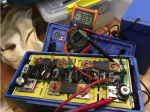You are using an out of date browser. It may not display this or other websites correctly.
You should upgrade or use an alternative browser.
You should upgrade or use an alternative browser.
Victron Energy: Alternator/Solar Charging - LFP Battery System
- Thread starter shade
- Start date
shade
Well-known member
If you get tired of waiting, one of these would make a nice Christmas present.Once you get past basic electronics tinkering, a good bench power supply with dual readouts and adjustments is worth its weight. I have been checking ebay trying to catch a university upgrading their EE lab, but no luck yet.
Programmable DC Power Supply - Volteq - Reliable Regulated Variable DC Power Supplies
Volteq is a leading manufacturer of regulated variable DC power supplies.
shade
Well-known member
I dug up a top balancing recommendation from Victron:
"You can temporarily set the float voltage at 14,2 volt to do this."
Which is 3.55V/cell. That'll do.
"You can temporarily set the float voltage at 14,2 volt to do this."
Which is 3.55V/cell. That'll do.
Last edited:
shade
Well-known member
I like how the overvoltage cutoff controls work on this power supply. There's a dedicated "OV" LED on the front panel that's hard to miss, the main display shows "Overvoltage enabled.", and a reset requires pressing a momentary plunger switch on the rear of the unit to clear it while the supply is disconnected from a load. I know I could screw that up, but it'd be pretty hard to reset it and accidentally restore power.
I decided to use the timer function of the power supply instead of the battery charging mode. I think the battery charging mode works well for bulk charging, but it won't maintain charging above about 90% SOC. After two hours at 14.20V, amperage dropped off to around 1A, and the battery is resting at 3.48V per cell.
Six hours of rest, 3.4V.

I decided to use the timer function of the power supply instead of the battery charging mode. I think the battery charging mode works well for bulk charging, but it won't maintain charging above about 90% SOC. After two hours at 14.20V, amperage dropped off to around 1A, and the battery is resting at 3.48V per cell.
Six hours of rest, 3.4V.

Last edited:
shade
Well-known member
I found some photos of an older Victron LFP battery going topless. There are larger versions of the photos via that link. While interesting, Victron has changed to active balancing and added Bluetooth, so there may be significant changes.


dreadlocks
Well-known member
they potted everything well enough you wouldn't get any chip ID anyhow.. looks rather sturdy tho, you can see detailed QC in all the markings.
luthj
Engineer In Residence
Looks robust. The prismatics mean you have 2 full layers of case for protection. Looks like serial communications between each cell board. The good news is that if the BMS goes belly up, you can always wire your own in easily. Given how many cycles you could see from the pack, they may outlast the BMS. Though with the relay disconnect being external its not terribly likely.
I am not a huge fan of the board being underneath the bus bars, but it does have good contact area.
I am not a huge fan of the board being underneath the bus bars, but it does have good contact area.
shade
Well-known member
I'll see if I can find some photos of the current models. I doubt they've gone to a worse design, but you never know.
I found the cells in the old battery: Winston WB-LYP60AHA. In the linked photo below, I can make out the red + ring, the case is the correct colour, and the model number is visible on the extreme lower-right.


I found the cells in the old battery: Winston WB-LYP60AHA. In the linked photo below, I can make out the red + ring, the case is the correct colour, and the model number is visible on the extreme lower-right.


Last edited:
shade
Well-known member


Marine lithium batteries in operation | Nordkyn Design
This article details the relations between voltage, state of charge, current and temperature for lithium iron phosphate (LFP or LiFePO4) battery banks.
nordkyndesign.com
Based on that, 3.40V seems as high as I'll likely ever want to see.
luthj
Engineer In Residence
Not exactly. The charging rate at voltage that low takes forever. Typically you need at least 13.8V if you want higher charge rates and faster taper near the end. There isn't any detriment to the pack life at even 14V as long as you terminate the charge using a return current parameter.
shade
Well-known member
I meant 3.4V as a resting voltage, not for charging. I let mine top balance at 3.55V/14.2V for an hour and called it good. Iirc, it was only accepting >1A at that point, so I think it was as close to 100% SOC as I'll ever take it.Not exactly. The charging rate at voltage that low takes forever. Typically you need at least 13.8V if you want higher charge rates and faster taper near the end. There isn't any detriment to the pack life at even 14V as long as you terminate the charge using a return current parameter.
After 12 hours resting, the battery is at 3.38V/13.52V, with all four cells in agreement. Time to run some loads before storage.
Last edited:
shade
Well-known member
More internal photos of Winston cells. I can see why letting them flop around on their sides could cause problems over time.




Similar threads
- Replies
- 6
- Views
- 1K
- Replies
- 30
- Views
- 8K
- Replies
- 3
- Views
- 2K
- Replies
- 0
- Views
- 632
